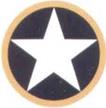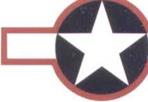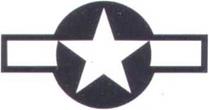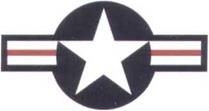The History Of USAAF Aircraft Markings, Insignia, Camouflage, And Colors
This volume covers the history and development of how and why the US Army Air Forces finished and marked their aircraft, between 1941 and 1947. The US Army Air Forces was formed out of the earlier unsatisfactory command structure, when in March 1941, the Secretary of War, Henry L. Stimson, directed that action be taken to place the existing Air Corps and Army Air Force Combat Command (which had replaced the earlier GHQ Air Force) under one command. Shortly after this, he revived the office of Assistant Secretary of War for Air; the new secretary, Robert A. Lovett, proceeded to promote increased aircraft production and to streamline the Army air arm.
The resulting reorganization created the new Army Air Forces (note the plural form of the title) on June 20, 1941 with General H. H. Arnold appointed as its Chief, directly responsible to the Army Chief of Staff. The new AAF was superior to the Air Corps and the Air Force Combat Command. Under Arnold, Maj. Gen. George H. Brett, the new Chief of the Air Corps, and Lt. Gen. Delos C. Emmons, commanding general of the Air Force Combat Command, were made responsible for service and combat functions, respectively.
However, it soon became apparent that there were still defects in the new organization, but it was not until early in 1942 that these were finally rectified by making the AAF a virtually autonomous force within the War Department. These changes had been made possible by official recognition of the major part airpower had played in the Nazi conquest of Europe, and the Japanese attack on Pearl Harbor.
As a result, a new War Department Circular, No. 59, was issued on March 2,1942, effective on March 9,1942. This abolished the Army GHQ, and placed the AAF on the same level as the ground army, if not as that of the Army itself. The earlier Office of the Chief of the Air Corps and the Air Force Combat Command were abolished. Despite this new directive, Gen. Arnold still obtained most of his authority, as head of an all-but independent air force, from being a member of the American-British Combined Chiefs of Staff (CCS) and the American Armed Forces Joint Chiefs of Staff (JCS), formed in February, 1942.
However, this new command structure did get the AAF a position commensurate with its growing size and power. This resulted in Gen. Arnold and the AAF assuming a role in the war effort far greater than that prescribed in War Department Circular No. 59. This finally reached a point where the AAF reached a quasi-equality with the Army and Navy, as compared to its actual legal status of equality with the Army ground and service forces.
Very rapid growth of the AAF resulted in the formation of no less than sixteen separate Air Forces world-wide. First of these were the Northeast, Northwest, Southeast, and Southwest Air Forces, within those areas of the continental USA. These soon became the First, Second, Third, and Fourth Air Forces. The Fifth, Seventh, Tenth, Thirteenth, Fourteenth, and Twentieth Air Forces served in the Chinese-Burma-Pacific theaters; the Eighth, Ninth, Twelfth, and Fifteenth in the Europe-Mediterranean theaters; the Sixth in the Panama Canal Zone, and the Eleventh in Alaska. The Eighth Air Force was re-deployed to the Pacific theater in 1945, after the end of the war in Europe.
Other specialized commands were eventually formed, including the Technical Training Command and the FlyingTraining Command (these were later merged into a single Training Command), Air Corps Maintenance Command, and the Air Corps Ferrying Command (this eventually became the Air Transport Command).
At the peak of its strength, the AAF had no less than 2,411,294 men in service, and 78,757 aircraft in its inventory. There were no less than 243 active groups in service by April 1945, and 224 of these were overseas. After the end of the war, the reduction in strength was very rapid and only 303,600 men remained in the service by May 1947. Less than four months later the AAF was replaced by the new, independent, US Air Force, on September 18, 1947. Planning for this event had actually begun in 1943, but it took all of this time before the Air Force finally became an equal partner with the Army and Navy.
To make the subject matter of this volume more manageable and understandable, it has been broken down into seven chapters and two appendices. Chapter 1 covers 1941, Chapter 2 1942, Chapter 3 1943, Chapter 4 1944, Chapter 5 1945-1947. Each of these chapters fully covers, in chronological order, the development of standard aircraft color schemes and finishes, development of camouflage color schemes and finishes, evolution of the national insig
nia, the markings for airplanes and airplane parts, unit insignia and tactical markings, and the evolution of standard color shades.
Chapter 6 covers briefly the development of the colorful Combat Aircraft Distinctive Markings for the Eighth Air Force in England, the special SHAEF “Invasion Stripes, and Unit Insignia”. Chapter 7 covers the development and usage of the standard USAAF aircraft color shades.
Appendix A covers the aircraft designation system used throughout the life of the AAF, and Appendix В covers the various aircraft maintenance markings used.
Photographs and color drawings have been included in each chapter and appendix, where applicable, to illustrate the application of the requirements to aircraft. Some photographs also illustrate mistakes or incorrect application of the requirements. With the vast number of aircraft used by the AAF, it is only possible to display a representative selection of their photographs, and the reader should also make use of the large number of titles published on the AAF for further reference. However, much incorrect or misleading information has been published on the subject of this book; readers are advised to use their discretion and make use of the official information contained in this volume.
All of the data in the text has been extracted from a huge variety of official documents, specifications, technical orders, memorandum, etc. produced by the AAF during the period covered by this volume. The AAF used a logical, uniform numbering system for all of its specifications, and all of the earlier aircraft ones fell into category 98-XX or 99-XX. The official nomenclature has been used throughout, including the various changes it went through. To save space, the reference “Specification Number” has been shortened to "Spec.”. In contrast to many other publications on this specialized subject, the author has given the full text of the main official documents. This allows the reader to follow the requirements laid down for USAAF personnel to follow, and those levied on the huge number of manufacturers involved during the war. In many of these requirements, the needs of our Allies also had to be considered and, indeed, there were many joint committees formed for just such needs.
Most of the time, the new USAAF cooperated very closely with its chief ally, the older British Royal Air Force, to their mutual benefit. However, as one reads the history of these events, it becomes apparent that there were two areas in which there appears to have been a degree of unwarranted chauvinism on the part of certain USAAF personnel. The first one was the tremendously slow effort to use white camouflage on the Anti-Submarine Command’s aircraft, like the RAF Coastal Command had been using very successfully for some time. In fact, the white scheme was not adopted until just before the USAAF handed over this duty to the US Navy.
The second area was the paint and colors to be used on the USAAF long range, high flying, Lockheed F-5 reconnaissance aircraft. Much effort was expended on the so-called haze paint schemes, but in the end various synthetic blue colors were used. This was despite the existence of well-developed color schemes in use by the RAF for the same duties. The discrepancy in this area is heightened by the later use of totally undocumented blue colors on various Consolidated F-7 (B-24 modified) aircraft for use in the Pacific. These color discrepancies were all the more surprising in view of the existence of the joint Army-Navy committee that issued the joint ANA 157 and 166 color bulletins. However, such events were very unusual, and contrary to the normal cooperation in effect until the end of the war.
To avoid confusion, all dates have been converted to the month/ day/year format. Some of the official nomenclature may seem strange, such as the use of the French word "cocarde” for the “star – in-circie” insignia in Specification 24114 of October 1940, but this was the official term used until the issue of the joint Army-Navy Spec. AN-I-9 in 1943.
To fully understand the use of the official documentation, it is necessary to realize that specifications were mandatory for use by both contractors and the service, while technical orders and technical instructions were only applicable within the service. However, waivers or deviations could be obtained by contractors in specific situations, when agreed to by the service. Although all of the specifications, etc., are dated, it did not necessarily mean that the requirement went into effect immediately, unless a mandatory compliance date was included. Effects of this lag in applying requirements are called out in the text, where known.
To clarify and coordinate the mass of data generated between 1941 and 1947, charts covering the specifications, technical orders, color specifications, etc., issued during each year, will be found near the front of Chapters 1 through 5.
These charts allow complete correlation of all of the service marking and color requirements for any given period, as detailed in each of the Chapters. To make it easier to find specific references in the text, many sub-headings indicate the more important data in all chapters. To save space, and endless repetition, several have been used in the captions to the photographs; these will be found in the list of abbreviations.
The publisher has decided to print the numerous standard USAAF color shades, rather than using inserted color chips. Every effort has been made to make the printed color shades as accurate as possible: those whose needs require the highest possible accuracy in color shades are requested to contact the author, via the publisher,
The author is aware that it has not been possible to include all of the available data in this volume; for example, it was found that the data for the section on the very colorful Combat Aircraft Distinctive Markings was so extensive that, after consultation with the publisher, it was decided to publish it later, as a separate work. Nevertheless, the author believes that this work covers a subject long demanding this kind of attention and has done his best to satisfy the objective; any errors that may be in this volume are his responsibility. He hopes that the reader will enjoy the volume and that they will inform him of any corrections or additions that may come to light.
|
|
|
|
 |
|
|
|
|
|
|
|
|
|
|
|
|
|
 |
|
|
|
|
|
|
|
|
|




![]()

![]()












